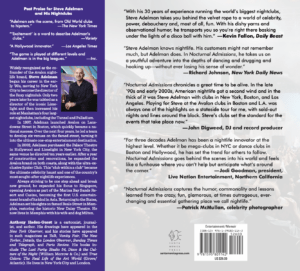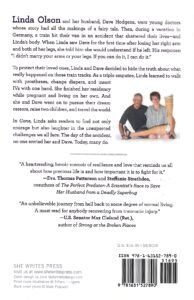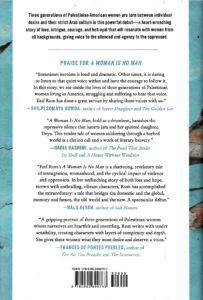
Book blurbs are the quotes you see on the back covers of many books and in online sales copy. They are an important part of an effective book marketing and promotion strategy.

A-list celebrities, cultural icons, or award-winning or mega bestselling authors (Colson Whitehead, Anthony Doerr, Michelle Obama) don't need book blurbs. Their books will sell based on the author's name, past performance, and topical relevance. The rest of us--especially first-time authors--need some social proof to be taken seriously.
If you aspire to be traditionally published, book blurbs aren't optional. Book blurbs help sell books, so publishers use them in many ways. But that assumes that a publisher finds your book and you as an author worth investing in.
Here's the cold, hard truth: Your eagerness to request book blurbs early in the process is a sign of your commitment to promoting your book. Many authors tell literary agents and publishers that they'll "do whatever it takes" to get their book in front of readers. The reality is that too few follow through.
When the time comes to get uncomfortable, many authors show their true commitment by a lack of meaningful action.
Including several high-value book blurbs in your pitch to literary agents and publishers shows that you're a self-starter and can be trusted to do the hard things when asked. It sets you apart from the hundreds of other author queries in their pile, the ones full of "I will do [x]" versus "I am doing [x]."
Action trumps intent.
The first action you're going to take is to make a list of genre/topic-related authors and experts or industry professionals--basically anyone you can think of whose credentials or brand aligns with you and your book and whose name and accomplishments will impress your ideal reader. This should be a long list.

Now place them in categories or rank them starting with the people you know or who are easily accessible. Are you a Harvard professor who's pitching a book that explores changing social constructs and the way humans interact under extreme stress? Great. Steven Pinker should be on your list. Better yet, ask him to write the foreword for your book. If he says, "Sorry, I'd love to, but I'm too busy." Ask him to write a blurb.
(Related: How to Ask Someone to Write a Foreword for Your Nonfiction Book)
These are the people who are most likely to say yes and to respond the fastest. It's also likely that because you know them and have the most in common with them when compared to other people on your list, you'll feel most comfortable asking them.
Add to your list the authors of books on your comp title list too.
I'm not comfortable telling a client that their query letter or book proposal is ready to pitch to literary agents or publishers until they have at least 3 but preferably 5 secured quotes. By secured quotes I mean that the blurb writer has said yes to the request and sent my client their blurb and preferred bio. The client and I then select from the blurb writer's bio to add a tag behind their name. (More on this below.)
So, start this process early because it can take a month or more to get yeses and the blurbs back.
Before I move on to the nitty gritty of this blog post, let's talk strategy and tactics.
As you've already seen, I recommend starting with the people who are most likely to say yes to you. One reason is to gather as many high-quality blurbs as possible in the shortest amount of time. The other reason is to rack up wins that create emotional and strategic momentum.
The more yeses you get, the more likely you are to want to keep adding to your list. And the more high-quality blurbs you have to choose from, the more attention you're likely to get from agents and publishers and the easier future requests will be for reasons we'll look at next and that I'll go into more in the next section.
For reasons I stated in the opening of this post, you need to have a minimum of 3 high-quality blurbs to include in your book proposal before you pitch to agents or directly to publishers that accept unsolicited manuscripts.
I recommend that my clients minimize their risk of being rejected by potential book blurbers by going after the low hanging fruit first. Get those easier ones and then put requests on hold, but include the list of people you will--not plan to, will--pursue when the time is right. Include a short bio tag to let the agent know how that person's blurb will attract readers.
Also include the names and bio tags of people who've committed to writing a blurb for you but have not yet done so. So you should have three categories: secured, pending, and pursuing.
Your agent will most likely initiate a conversation about securing more blurbs soon after they sign you and before they customize your book proposal to pitch to acquisition editors. If they don't, talk to them about when to send requests to the remaining people on your list and ask if they can think of others you should reach out to.
You can also use Publishers Marketplace to look up who represents any of the authors on your list. Give your agent a list of the authors and their agents in case your agent knows their agent and feels comfortable making the request on your behalf. (This is sometimes the best or only way to reach high-profile authors.)

Now's the time to send another follow-up note to people you've reached out to and either haven't heard back from or who committed to writing a blurb but haven't yet done so. My request follow-up strategy is a conversation for another day except for the follow-up notes at the bottom of the next section, but know that you should have one built into your plan.
Forward all blurbs to your editor as soon as you get them to ensure that they make it onto the cover or in the book's front matter and can be used in promotional material as your book enters the pre-publication promotional push.
But enough of that, let's get to my book blurb request template.
Asking someone to praise our work is uncomfortable for many of us. Many of us don't like self-promotion, and fear of rejection is a predictable human emotion. I've developed this approach to minimize those things. Here's my template with a few specifics from one of the projects I worked on:
Hello, [Name].
My name is [Your Name], [short book-relevant bio]. I’m reaching out to you today because [reason you think your book will resonate with them/reflect their values], and I’d like to see if you’d be willing to write a book blurb/endorsement for me to use when promoting my book.
You may already be familiar with the process, but in case you aren’t, below is an overview of the book and sample blurbs/endorsements to make this as easy as possible for you:
[Book Title: Subtitle] is [short paragraph describing your book--usually what you plan to use as back cover copy].
If this is the kind of project you like to support, feel free to read the overview below and write a few short sentences that sum up your reaction and what you think will resonate with readers. Here are a few blurbs written about other books like mine that you may find helpful as you decide what to write:
[“Michael Bennett invites us into a vision of justice and liberation that is simply irresistible. This book is pure fire.” Naomi Klein, author of No Is Not Enough about Things That Make White People Uncomfortable
“Even in a predominantly liberal community, his message of law and order, accountability, and self-empowerment resonates. He is one of America’s most important cultural voices.” Mark Belling Talk Radio Host for 1130 WISN-AM in Milwaukee and columnist for newspapers including the Milwaukee Post about Cop Under Fire]
Or if you prefer to keep it short and sweet, here are some one-line reviewer comments about various books:
[“Shocking, insightful, and powerful.”
“A story every [noun] should read.”
“Equal parts insight and humor, [Title] is a must read.”]
Thank you for your consideration. Please let me know if you have any questions.
[Author Name]
P.S. If you'd prefer to read the entire manuscript before commenting, please let me know. I'd be happy to send a PDF when the book's interior layout is done.
Expanded Outline
[I recommend adding your book's expanded Table of Contents (chapter titles and subheadings) here and below that chapter synopses from or similar to the ones you included in your book proposal. This gives most potential book blurb writers enough information to write a high-quality endorsement without investing a lot of time to do so.
If yours is a novel, skip this step and let the short overview in the main body of your email and offer to send them some form of an advanced reader copy stand.]
GENERAL NOTE: You may have noticed that examples of book blurbs in the template above came from two books with two distinct and arguably opposing views. That's okay. I selected them from a list of titles in my client's competitive analysis and because they reflected each book's message and appeal to a specific group of reader, which is what separates adequate blurbs from great ones.
TIER 1 NOTE: This version, which uses blurb examples from comp titles, can be modified as blurb come in. If there's one that's particularly flattering or creative, replace one of the comp title blurbs with it. Not only will it be more specific, it may persuade the person you're asking to say yes if they see who's already endorsed you.
TIER 2 NOTE: After you sign with a literary agent, I also recommend adding something along the lines of "I'm represented by [name of agent] at [agency]" after you introduce yourself in the opening line of the request template. Securing agent representation shows that your project "has legs" and that your request is worth serious consideration.
TIER 3 NOTE: If you're sending this out during the production phase of your book and as part of your launch campaign, add something along the lines of "coming [scheduled launch date OR soon] from [publisher name]" somewhere in the first 1/3 of the letter, wherever it naturally fits, and be sure to include a needed-by date in your blurb request.
FOLLOW-UP NOTE: I purposely do not include a deadline in the initial email because I don't want to create pressure or elicit an automatic no. For those that immediately respond, say thank you and let them know that you need their quote by [date that is 10-14 days in the future, enough but not too much time].
Wait 1 week and then reach back out to those who haven't responded. Let them know that you'll be submitting to literary agents (or whatever your next deadline/milestone is) on [date that is 14-21 days in the future] and would sincerely appreciate being able to include their quote at that time. This may be bad timing or too much pressure for some people, so leave the door open if you can by adding that if this isn't the best timing for them you'd be happy to reach out when the project is further along.
In addition to the reasons highlighted in the notes above, this approach works because it tells the recipient everything they want to know in a tight package:
But it goes beyond that. It removes objections.
You're too busy? Of course you are. I already thought of that. Here's the expanded--but still short--overview and some blurb examples that you can use as a template to make this really easy. I also included several timing options, so you can fit this in when it's most convenient for you.
You need to see more before committing because you're careful about who you endorse? I respect that and have a plan for how and when to give you what you need to make an informed decision.
You just wouldn't even know what to say? No worries. These things can be daunting, especially if you've never written one before. Here are several examples to fit a variety of communication styles.
And did you notice that the template is free of hype. There's not even a whiff of obnoxious statements such as "This is the best book you'll ever read," "a guaranteed bestseller," or "You're going to want to be associated with this one." Nope. This is designed to be a professional request made from one person to a predictably like-minded other person.
If the recipient says no, it's not a reflection on you. It simply means you truly caught them at a bad time or yours isn't a project that resonates with them. That's not a rejection; it's just a No thank you; I already ate kind of thing.
First, it's important to highlight that there is no such thing as too many book blurbs.
You or you and your publisher will choose the best ones to go on your book's back cover based on two criteria: the descriptive value of the quote and the blurb writer's name recognition or credentials. Consider the following made-up example:
"A must-read." --Cecily Jones
OR
"If you only read one survivor memoir this year make it this one." --Felicia Smith, trauma surgeon and author of New York Times bestselling What's Next? Surviving and Thriving After a Traumatic Injury
It's not hard to see that the first has little if any value while the second is relatively specific and written by someone who most prospective readers would respect even if the author and title of their book aren't on the potential book buyer's radar.
As room allows, create a mix that highlights different aspects of your book to appeal to the widest audience possible. (See the example from Steve Adelman's book above.)
Any blurbs that don't fit on your back cover can be added to the front matter of the book and labeled "Advance Praise."
In addition to putting blurbs on and in your actual book where potential book-buyers and readers can see them, add the best ones to your online sales pages. Below is an example of Linda K. Olson's memoir.

Just because they're called book blurbs doesn't mean you can only use them on your book. Think of them as praise to remind you that they are assets that can be used beyond the context of the book itself.
You could create a series of Instagram images with the quote and your book cover, perhaps posting one a day for the week or two leading up to your book launch and, of course, any time thereafter.
Think of ways to use them in your email signature, newsletter, or your author bio or elevator pitch.
And use them on your website!
The multi-purpose potential of book blurbs makes them the perfect asset for authors who hate self-promotion and want to avoid repeating "Buy my book" again and again and again. They give you something to talk about in a way that lets someone else talk about you. It's hard to overestimate their long-term value.
In keeping with the golden rule of writing--Show; don't tell--I recommend going beyond a thank-you email or even hand-written note. Do at least one of those immediately after the blurber replies, but go beyond that when your book is published. Send each blurb writer a physical copy of your book with a hand-written thank you on its title page.
One of the most meaningful ways to show your gratitude and respect for the time and energy your blurb writers expended on your behalf is to make sure their blurb is seen by as many people as is reasonable. This is especially true for blurb writers who are authors themselves because their blurb and the bio tag that follows also promotes their book(s).
Gathering book blurbs and using them often and with purpose shows literary agents, publishers, and readers that you're serious about getting your story or message into the hands of as many readers as possible. And in the absence of other subjective measurements, effectively positioning your blurbs allows potential readers, media professionals, booksellers, librarians, and more to make a buying decision about your book.
Remember that your book does not exist in a vacuum. You as an author do not exist in a vacuum. You and your book are being compared to an unknown number of others. The number and quality of endorsements an author receives before their book is published is one of the best measures I've seen for how successful a book will be when it's available for purchase.
Cristen Iris
CI Communication Strategies
2022
